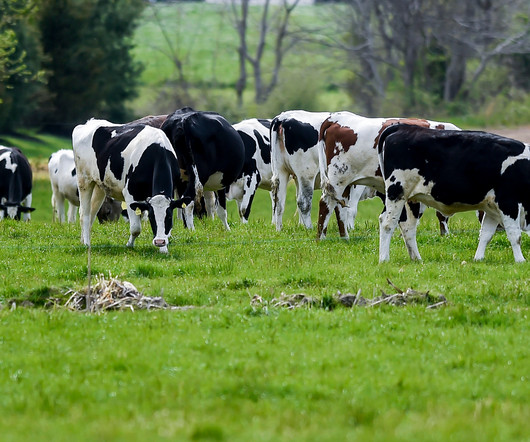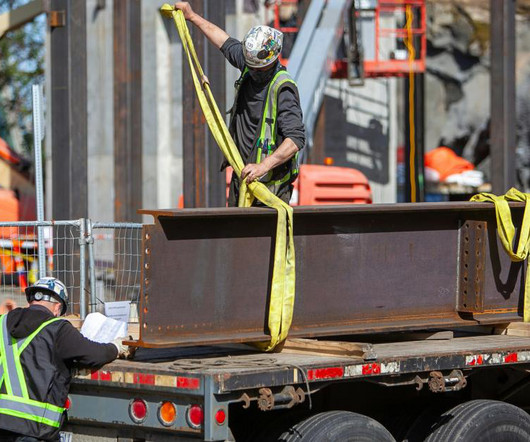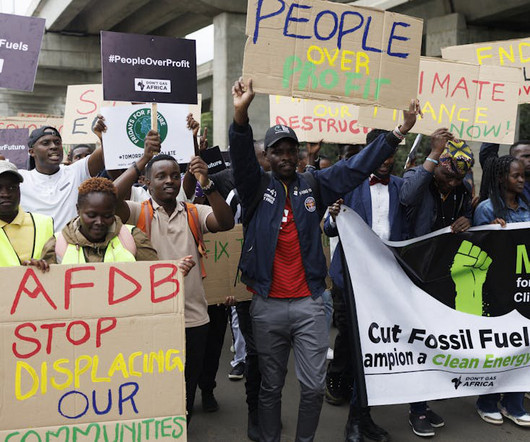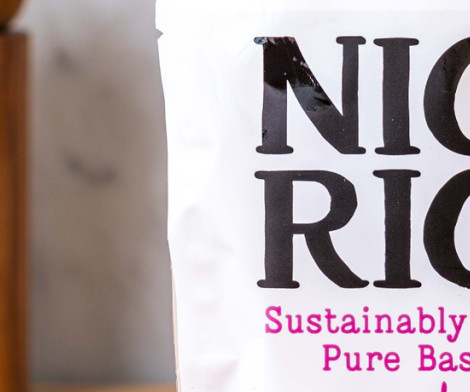Earth is more sensitive to greenhouse gases than we thought
New Scientist
JUNE 24, 2025
Our climate seems to be more sensitive to greenhouse gas emissions than some researchers had hoped, meaning the world will have to up its decarbonisation efforts
This site uses cookies to improve your experience. To help us insure we adhere to various privacy regulations, please select your country/region of residence. If you do not select a country, we will assume you are from the United States. Select your Cookie Settings or view our Privacy Policy and Terms of Use.
Cookies and similar technologies are used on this website for proper function of the website, for tracking performance analytics and for marketing purposes. We and some of our third-party providers may use cookie data for various purposes. Please review the cookie settings below and choose your preference.
Used for the proper function of the website
Used for monitoring website traffic and interactions
Cookies and similar technologies are used on this website for proper function of the website, for tracking performance analytics and for marketing purposes. We and some of our third-party providers may use cookie data for various purposes. Please review the cookie settings below and choose your preference.
 Greenhouse Related Topics
Greenhouse Related Topics 
New Scientist
JUNE 24, 2025
Our climate seems to be more sensitive to greenhouse gas emissions than some researchers had hoped, meaning the world will have to up its decarbonisation efforts

Legal Planet
JANUARY 8, 2025
In a series of posts (beginning here , and ending here ) last month, I outlined an approach to climate policy that emphasizes the role of subsidies in building political support and technological progress for climate policy. In doing so, I drew heavily on existing political science research and case studies from North America and Europe.
This site is protected by reCAPTCHA and the Google Privacy Policy and Terms of Service apply.

Legal Planet
JULY 31, 2025
Why hasn’t there been more movement against greenhouse gas emissions caused by animal agriculture? The 2006 FAO report mentioned earlier, which criticized animal agriculture’s contribution to greenhouse gas emissions, faced backlash from industry lobbyists and donors who pressured the FAO to change course.

Legal Planet
NOVEMBER 4, 2024
The program requires oil companies to continually reduce the greenhouse gas emissions of California’s transportation fuels. It’s what CARB must do again now. The Low Carbon Fuel Standard is one of California’s most innovative policy successes.

Inside Climate News
NOVEMBER 2, 2024
In one of three new reports on emissions, UN officials went as far as saying that the Paris Agreement’s goal of limiting warming to 1.5 degrees Celsius may be out of reach.

Union of Concerned Scientists
JULY 9, 2025
The opinion included the key fact that 71% of greenhouse gas emissions between 1988 and 2017 could be traced to just 90 companies, the Carbon Majors. Along these same lines, the Court specified that certain business have greater responsibilities due to their cumulative, historical contributions.

Real Climate
NOVEMBER 23, 2024
Similarly, there have been increases in other greenhouse gases , which Gavin nicely describes in his recent post Operationalizing Climate Science. In a nutshell, they are responsible for climate change, mainly due to an increased greenhouse effect.

New Scientist
JULY 22, 2025
Read more The jet stream may be starting to shift in response to climate change Aerosol pollution, which mainly comes from burning fossil fuels, typically has an opposite effect to greenhouse gases. By some estimates, aerosol pollution has masked as much as half of the warming effect of greenhouse gases to date.

Inside Climate News
NOVEMBER 4, 2024
and western Europe while intensifying production elsewhere could drastically cut greenhouse gas emissions, with little hit to global protein production, a new study shows. Removing cattle from carbon-rich soils in the eastern U.S.

Legal Planet
FEBRUARY 28, 2025
Circuit decision that upheld EPAs finding emission of greenhouse gases endangers human health and welfare. It also upheld the Obama Administrations pathbreaking regulation of greenhouse gases from vehicles. Coalition for Responsible Regulation v. EPA (2012 ). This is a D.C.

Legal Planet
OCTOBER 30, 2024
Achieving climate goals requires significant investments in clean energy, transportation, and other climate technologies to reduce greenhouse gas emissions and remove carbon from the atmosphere.

Enviromental Defense
DECEMBER 12, 2024
In recent advice to the government, the Net Zero Advisory Body made clear that even a 50 to 55 per cent reduction wouldnt represent Canada doing its fair share in reducing greenhouse gas pollution. This disappointing target cements Canadas position as a global climate laggard. Provincial governments share the blame.

Environmental News Bits
JULY 14, 2025
Greenhouse gas emissions of tomato production and supply: A systematic review. This study … Continue reading Greenhouse gas emissions of tomato production and supply: A systematic review Zhu, Z., & Miller, S. Resources, Conservation and Recycling, 218, 108236.

Environmental News Bits
DECEMBER 6, 2024
Environmental Protection Agency issues an exhaustive report on greenhouse gas emissions, by source, economic sector and other factors that track data going back to 1990.

Union of Concerned Scientists
MARCH 18, 2025
Previous attribution research published by my Union of Concerned Scientists colleagues have allowed us to draw causal connections between sources of heat-trapping emissions and resulting impacts, like present day increases in atmospheric greenhouse gas concentrations, air temperatures, sea levels , ocean acidification , and wildfire burned area.

Legal Planet
NOVEMBER 11, 2024
greenhouse gas emissions and 0.1% The eighty-mile stretch of track in question would connect the Uinta Basin with the national rail network. The main purpose is to provide a way to get a lot more oil and possibly some minerals to market. The Basin’s oil production would represent up to 0.8% of global emissions.

Enviromental Defense
NOVEMBER 4, 2024
Statement from Aly Hyder Ali, Oil and Gas Program Manager, Environmental Defence Ottawa | Traditional, unceded territory of the Algonquin Anishinaabeg People – We welcome the Government of Canada’s Oil and Gas Greenhouse Gas Pollution Cap draft regulation, which aims to curb pollution from the oil and gas industry.

Environmental News Bits
JUNE 23, 2025
Humans are on track to release so much greenhouse gas in less than three years that a key threshold for limiting global warming will be nearly unavoidable, according to a study to be released Thursday.

Legal Planet
OCTOBER 14, 2024
Meanwhile, deforestation continues apace and greenhouse gas concentrations continue to rise toward irreversible tipping points. And even among those companies that do practice offsetting, total credit purchases make up an average of less than 3% of their overall carbon footprint. Credits are a tiny part of the picture.

Physics World
APRIL 2, 2025
In a recent study headed up at the Institute for Microelectronics and Microsystems ( IMM ) in Italy, Alessandra Alberti and colleagues investigated the potential of semi-transparent perovskite solar cells as coatings on the roof of a greenhouse housing radicchio seedlings. Experimental set-up The laboratory-scale greenhouse.

Real Climate
MAY 12, 2025
Thawing permafrost may release methane into the atmosphere, which subsequently increases the greenhouse effect and leads to further global warming. The overall Arctic ice loss has contributed far more to global sea-level rise than any other region on Earth.

Earthava
NOVEMBER 13, 2024
Plastic waste contributes to climate change by releasing greenhouse gases during its production, degradation, and incineration. The post Plastic Pollution and Climate Change: Understanding Their Interconnected Impact on Our Planet appeared first on Earthava.

PA Environment Daily
DECEMBER 5, 2024
Participants in this free one-hour webinar will learn about conventional orphaned well plugging, remediation, and restoration, with a focus on reducing methane and greenhouse gas emissions. The Penn State Extension will host a December 12 webinar on Carbon Reduction Credits In Oil and Gas Well Plugging from Noon to 1:00 p.m.

Inside Climate News
NOVEMBER 14, 2024
By Georgina Gustin At its annual conference on climate change this week, the United Nations released a major report saying the world has little hope of reaching global climate targets without quickly lowering emissions of nitrous oxide, a greenhouse gas that’s nearly 300 times more powerful at warming the atmosphere than carbon dioxide.

Real Climate
MARCH 20, 2025
As well as the (now) standard set of graphs related to increasing greenhouse gas concentrations , rising temperatures , reducing glacier mass, etc., since the 1850-1900 baseline is very clearly associated with the increases in greenhouse gases, slightly (and decreasingly) modulated by the changes in atmospheric pollution.

Enviromental Defense
NOVEMBER 24, 2024
The result is that countries in the Global South have not been granted the necessary funds to adapt to climate disasters or to effectively reduce their own greenhouse gas emissions. The decision was unfairly steamrolled through opposition from the most vulnerable countries. We all know that a dollar today does not go as far as it used to.

Union of Concerned Scientists
MARCH 18, 2025
This long-term impact reflects the delayed response of ocean temperatures and ice sheet dynamics to past greenhouse gas emissions. Importantly, this projected rise is in addition to the sea level rise driven by emissions from all other sources.

Legal Planet
APRIL 8, 2025
A stream of data about methanea potent greenhouse gasis now constantly being beamed down from space. Methane is a powerful greenhouse gas, over 80 times more potent than carbon dioxide in a 20-year timespan. New methane satellites provide a powerful data capability for governments who want to demonstrate leadership in climate policy.

Scientific American
JULY 3, 2025
Four research firms project that the Republicans’ One Big Beautiful Bill Act will raise greenhouse gas emissions and likely put U.S. and global climate goals out of reach

PA Environment Daily
OCTOBER 26, 2024
million-- to reduce greenhouse gas emissions and improve water quality on more than 50 farms and the National Hemp Association -- $19.6 On October 25, US Senator Bob Casey announced $40 million in funding to the Department of Agriculture and Land O'Lakes Farmer Cooperative -- $21.2

Ocean Conservancy
NOVEMBER 11, 2024
The ocean absorbs more than 90% of the excess heat trapped by greenhouse gasses and generates 50% of the oxygen we breathe. Why the Ocean Matters at COP29 A thriving ocean supports resilient ecosystems, protects communities and enhances global efforts to keep global warming below 1.5°C.

Inside Climate News
MAY 7, 2025
By Miranda Lipton New research from the University of California, Davis on feeding seaweed to grazing cattle shows that the practice could significantly reduce the greenhouse gases released by livestock, which produce roughly 14.5 percent of the climate-warming emissions.

A Greener Life
JULY 27, 2025
By Anders Lorenzen A ruling by the highest global court, the International Court of Justice (ICJ), states that individual countries must protect their people and environment from greenhouse gas (GHG) emissions and act with due diligence to fulfil this obligation. degrees C above pre-industrial levels.

Legal Planet
OCTOBER 17, 2024
People now really are discussing the possibility of making intentional interventions to change the climate — or rather, to reduce some of the climate disruptions that are happening and coming due to human elevated greenhouse gases. These interventions would not precisely offset greenhouse-gas-driven climate change.

Ocean Conservancy
APRIL 23, 2025
Currently, plastics drive at least 3-4% of global greenhouse gas emissions and are the fastest-growing demand for fossil fuels. Tackling the plastics pollution crisis is a perfect example. Plastics produce a major climate problem, and we can do something about that today.

NRDC
MAY 19, 2025
Reducing the greenhouse gas emissions of construction materials is critical to achieving full building decarbonizationand states can lead the way.

Real Climate
MARCH 18, 2025
We also know what is needed to stop global warming: the atmospheric concentrations of greenhouse gases such as CO2 and methane must stabilise, and the forests must be protected. References A. Dobler, R.E. Benestad, C. Lussana, and O. Landgren, "CMIP6 models project a shrinking precipitation area", npj Climate and Atmospheric Science , vol.

Environmental News Bits
NOVEMBER 14, 2024
The annual climate change conference must focus on holding corporations and countries accountable for greenhouse gas emissions. by Llewellyn Leonard, University of South Africa The 29th Conference of the Parties (COP29) takes place in Azerbaijan in November 2024.

A Greener Life
JANUARY 3, 2025
By Jeremy Williams Last year, I wrote about the out-sized carbon footprint of rice , which accounts for almost a quarter of all greenhouse gases from global food production. Half the world eats rice every day, so thats perhaps not surprising. However, theres no question that its much more damaging to the climate than other staple grain crops.

Legal Planet
AUGUST 8, 2025
Furthermore, plastic production, use and waste management account for around 4% of greenhouse gas emissions worldwide and its pollution is a major drive of biodiversity loss. Over 99% of plastic is made from chemicals sourced from fossil fuels , making the plastic industry and the fossil fuel industry interconnected.

Nature
AUGUST 12, 2025
Nature, Published online: 13 August 2025; doi:10.1038/s41586-025-09368-2 The main multidecadal variations in the PDO index during the twentieth century, including the ongoing, decades-long negative trend, were largely driven by human emissions of aerosols and greenhouse gases rather than internal processes.

Legal Planet
JULY 24, 2025
It’s been a long time coming but nations of the world officially have a legal obligation to limit their emissions of greenhouse gases or else pay reparations for the harms of climate change. Photo credit: UN/ICJ/Jeroen Bouman (CC BY-NC-ND 2.0)

PA Environment Daily
JULY 16, 2025
AFIG aims to lower greenhouse gas emissions and improve air quality for many Pennsylvania communities with the use of electric school buses, Renewable Natural Gas (RNG) trucks, electric charging stations, and other clean transportation alternatives.” The awards will save an estimated 1,262,825 gallons of gasoline per year.

PA Environment Daily
JANUARY 9, 2025
DEPs RISE PA Program will offer grants for small-, medium-, and large-scale decarbonization projects at industrial facilities to reduce greenhouse gas (GHG) and co-pollutant emissions. RISE PA DEP was awarded $396 million in funding from the EPA Climate Pollution Reduction Grant Program established by the federal Inflation Reduction Act.
Expert insights. Personalized for you.
We have resent the email to
Are you sure you want to cancel your subscriptions?

Let's personalize your content